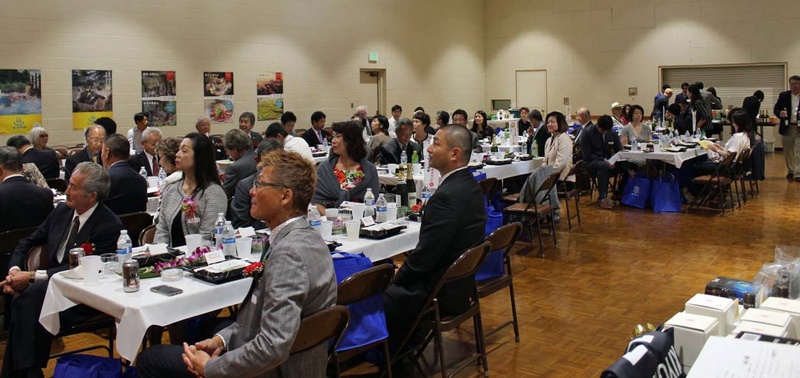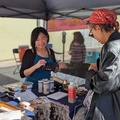I came to Los Angeles in 1992. I discovered that there were prefectural associations here, and I became somewhat involved with the Oita Prefectural Association of my hometown, but I hadn't been there in about 10 years.
In the fall of 2016, I had the opportunity to attend a social gathering with the Southern California Oita Prefecture Association and a group of people from Oita Prefecture who were visiting Los Angeles to promote Oita Prefecture specialty products in the American market. My eldest son, who was born in Los Angeles, wanted to continue his education in Japan, and moved to my parents' home in Oita City at the beginning of the year, which was also a motivation for me wanting to attend the gathering. And I truly enjoyed the social gathering.
Shortly after that, I was contacted by the current chairman, Yuji Aida (hereafter referred to as chairman). I was appointed to the executive committee for the Kenjinkai's event, which will mark its 100th anniversary in 2017. Other members included Thomas Ako, a real estate agent; Mariko Yamazawa, who is currently retired; Fumiko Kugimiya, who ran a school in Oita City before moving to the United States; and Eri Ihara, the wife of a missionary (later joined by Mike Harazawa). At that time, the number of members was 40. It was not expected that many of them would participate in the event. So, on what scale and how should we celebrate?
At first, the chairman's idea was to make a commemorative item and hold a dinner party for members. However, Fumiko, who had just moved from Oita to Los Angeles via New York, disagreed, saying, "The charity event in New York for the Oita and Kumamoto earthquakes was a great success. We should celebrate the 100th anniversary in a big way."
Footwork and decision-making
I often cover the Okinawa Prefectural Association, which is known for its large size and active activities. However, what I have seen from my many visits to the Okinawa Prefectural Association is that there are only a few core members involved in running the association. A few people spend a huge amount of time dealing with a large number of members, and are engaged in activities with great mobility. The Oita Prefectural Association may have a small number of members, but judging from the members of the executive committee, all of them are blessed with agility and decisiveness. I know I am blowing my own trumpet here. I began to think, "Okay, we can definitely make the event a success." Before I even decided what to do.

The chairman acted quickly after that (later recalling that, "I made up my mind at that moment"). The first meeting was held in December 2016, and the venue was decided to be the Gardena Buddhist Church, where Eri's husband serves as a missionary. At first, a nearby hotel was also considered. However, it was decided that the most flexible venue would be a Buddhist church where family members are present. This turned out to be the right decision.
The program included a congratulatory speech, an opera by Tom Mooney, Fumiko's husband and singer, a chorus group performance by former chairman Hiroyuki Goto, a lecture on the Oita dialect by Eri's father, an Ogura drum performance, and a raffle. The prizes were collected energetically by Mariko, a former successful saleswoman at a moving company, from her former clients. The chairman, who has a wide network, also collected enough prizes for almost everyone, including a round-trip ANA flight from Los Angeles to Tokyo.
It is customary for a prefectural association to print a commemorative booklet for its 100th anniversary. The booklet contains advertisements from member companies. The advertising revenue is used to cover the running costs of the event. However, we at the Oita Prefectural Association do not have the manpower to edit the booklet or handle advertising sales. So we decided to be realistic and create a four-page color program. We asked a professional to design it. It was Ritsuko Lynch, a designer I often work with as a freelance editor. Her parents are also from Oita Prefecture. Ritsuko's idea was to feature Bungo plum blossoms on the cover of the program, and the logos of 16 companies and two local governments were lined up as sponsors.
The bento boxes were ordered from Koto, a long-standing popular Japanese restaurant. The owner and chef, Matsuki-san, has over 40 years of experience as a sushi chef and was also the manager of the Ginza branch of Tsukiji Tamazushi. Not only was the authentic taste well-received by the participants, but as the "bento person in charge," I was also touched by Matsuki-san's humble attitude as a chef as I interacted with him.
Ownership and enthusiasm
The 100th anniversary event was held on September 30th, 2017. Thanks to the chairman's encouragement and efforts, the number of attendees was 80. 14 people participated, including members of the Oita Prefectural Association, the chairpersons of other prefectural associations in Southern California, and from Japan, including Vice Governor Ando Takashi of Oita Prefecture, Mayor Sato Kiichiro of Oita City, and Himeno Kiyotaka, chairman of the newly established Oita Japan-America Society and president of the Oita Chamber of Commerce and Industry. Moreover, the number of members of the Oita Prefectural Association was 40 a year ago when preparations began, but by the time of the 100th anniversary event, it had increased by 12 to 52.

The event proceeded in a friendly atmosphere. People were seen enjoying Iichiko from Sanwa Shurui, an Oita Prefecture company, and Ginza no Suzume from Yabu Shuzo at the bar. The 100th anniversary, which had been in preparation for a year, ended with the smiles of the participants who had gathered from all over the country.
Nanako Kawabun, a graduate of Ritsumeikan Asia Pacific University in Beppu, Oita Prefecture, who became a new member, said, "It was my first time participating, but everyone welcomed me warmly and it was a fun and meaningful time. I would like to participate in future events and contribute in some way." Tadayuki Yakushiji, representative of the Oita Prefectural Association International, who participated from Tokyo, also commented, "I would like to express my respect to Chairman Aida and the other members of the management team for hosting a wonderful ceremony, welcoming guests from Oita Prefecture and Oita City, despite being a volunteer organization. From now on, it may be time to recruit members widely, not just from people from Oita, but also from people who have been there and who like it."
Finally, having just celebrated the 100th anniversary, the chairman spoke about the challenges ahead, saying, "We need to get people who can act to become members. At least if the association is close-knit, I think it's better for it to be flexible. I strongly feel that gathering as many members as possible who can show some interest and support is essential for the survival of the prefectural association." I feel the same way. What is necessary for the survival of a prefectural association is "members who can work with a sense of ownership and enthusiasm." As one of the executive committee members, I am proud that the Southern California Oita Prefectural Association has been able to prove this at the turning point of its 100th anniversary.
© 2017 Keiko Fukuda






